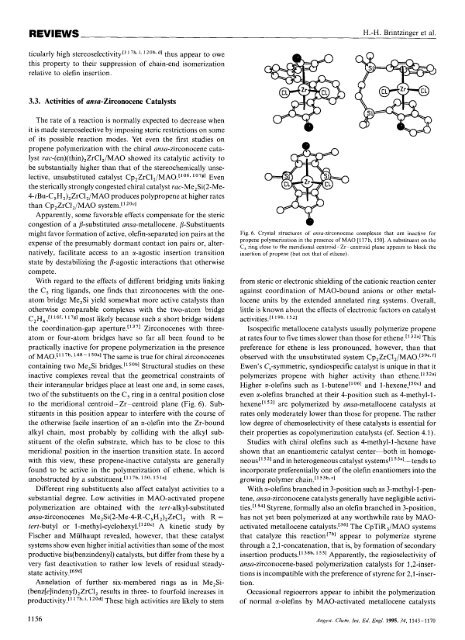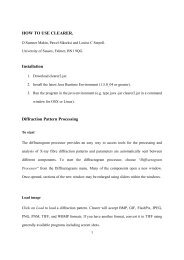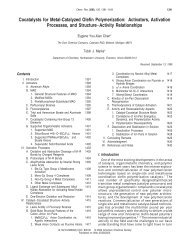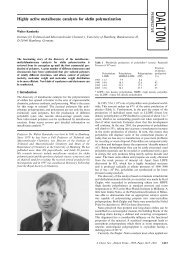Stereospecific Olefin Polymerization with Chiral Metallocene Catalysts
Stereospecific Olefin Polymerization with Chiral Metallocene Catalysts
Stereospecific Olefin Polymerization with Chiral Metallocene Catalysts
You also want an ePaper? Increase the reach of your titles
YUMPU automatically turns print PDFs into web optimized ePapers that Google loves.
REVIEWS H.-H. Brintzinger et al.<br />
titularly high stereoselectivity'" 7h,i- 120b*d1 th us appear to owe<br />
this property to their suppression of chain-end isomerization<br />
relative to olefin insertion.<br />
3.3. Activities of ansa-Zirconocene <strong>Catalysts</strong><br />
The rate of a reaction is normally expected to decrease when<br />
it is made stereoselective by imposing steric restrictions on some<br />
of its possible reaction modes. Yet even the first studies on<br />
propene polymerization <strong>with</strong> the chiral ansa-zirconocene cata-<br />
lyst rac-(en)(thin),ZrCI,/MAO showed its catalytic activity to<br />
be substantially higher than that of the stereochemically unse-<br />
lective, unsubstituted catalyst Cp2ZrCI,/MA0.['06~ Even<br />
the sterically strongly congested chiral catalyst rac-Me2Si(2-Me-<br />
4-tBu-C5H,),ZrC1,/MA0 produces polypropene at higher rates<br />
than Cp,ZrCI,/MAO system." 2ocl<br />
Apparently, some favorable effects compensate for the steric<br />
congestion of a p-substituted ansa-metallocene. p-Substituents<br />
might Favor formation of active, olefin-separated ion pairs at the<br />
expense of the presumably dormant contact ion pairs or, alter-<br />
natively, facilitate access to an cc-agostic insertion transition<br />
state by destabilizing the 8-agostic interactions that otherwise<br />
compete.<br />
With regard to the effects of different bridging units linking<br />
the C, ring ligands, one finds that zirconocenes <strong>with</strong> the one-<br />
atom bridge Me,Si yield somewhat more active catalysts than<br />
otherwise comparable complexes <strong>with</strong> the two-atom bridge<br />
C2H4,[116'. "'gl most likely because such a short bridge widens<br />
the coordination-gap aperture."371 Zirconocenes <strong>with</strong> threeatom<br />
or four-atom bridges have so far all been found to be<br />
practically inactive for propene polymerization in the presence<br />
of MA0.[1'7b, 14*- The same is true for chiral zirconocenes<br />
containing two Me,Si bridges.['50b1 Structural studies on these<br />
inactive complexes reveal that the geometrical constraints of<br />
their interannular bridges place at least one and, in some cases,<br />
two of the substituents on the C, ring in a central position close<br />
to the meridional centroid-Zr-centroid plane (Fig. 6). Substituents<br />
in this position appear to interfere <strong>with</strong> the course of<br />
the otherwise facile insertion of an r-olefin into the Zr-bound<br />
alkyl chain, most probably by colliding <strong>with</strong> the alkyl substituent<br />
of the olefin substrate, which has to be close to this<br />
meridional position in the insertion transition state. In accord<br />
<strong>with</strong> this view, these propene-inactive catalysts are generally<br />
found to be active in the polymerization of ethene, which is<br />
unobstructed by a substituent.["7b* I5O,<br />
Different ring substituents also affect catalyst activities to a<br />
substantial degree. Low activities in MAO-activated propene<br />
polymerization are obtained <strong>with</strong> the tert-alkyl-substituted<br />
ansa-zirconocenes Me,Si(2-Me-4-R-C,H2),ZrCI2 <strong>with</strong> R =<br />
tert-butyl or 1-methyl-cyclohexyl.~'20c1 A kinetic study by<br />
Fischer and Mulhaupt revealed, however, that these catalyst<br />
systems show even higher initial activities than some of the most<br />
productive bis(benzindeny1) catalysts, but differ from these by a<br />
very fast deactivation to rather low levels of residual steady-<br />
state<br />
Annelation of further six-membered rings as in Me2%<br />
(benz[e]indenyl),ZrCl, results in three- to fourfold increases in<br />
productivity.[' ' 7h-i, lZodl These high activities are likely to stem<br />
Fig. 6. Crystal structures of unsu-zirconocene complexes that are inactive for<br />
propene polymerization in the presence of MA0 [117b, 1501. A substituent on the<br />
C, ring close to the meridiondl centroid-Zr-centroid plane appears lo block the<br />
insertion of propene (but not that of ethene).<br />
from steric or electronic shielding of the cationic reaction center<br />
against coordination of MAO-bound anions or other metallocene<br />
units by the extended annelated ring systems. Overall,<br />
little is known about the effects of electronic factors on catalyst<br />
activities,I1 19b. 1521<br />
Isospecific metallocene catalysts usually polymerize propene<br />
at rates four to five times slower than those for ethene.['32"] This<br />
preference for ethene is less pronounced, however, than that<br />
observed <strong>with</strong> the unsubstituted system Cp2ZrCI,/MA0.[39e~<br />
Ewen's C,-symmetric, syndiospecific catalyst is unique in that it<br />
polymerizes propene <strong>with</strong> higher activity than ethene.1' 32al<br />
Higher sr-olefins such as l-butener'061 and l-he~ene,~~~'] and<br />
even cc-olefins branched at their 4-position such as 4-methyl-1 -<br />
hexene" 521 are polymerized by ansa-metallocene catalysts at<br />
rates only moderately lower than those for propene. The rather<br />
low degree of cheinoselectivity of these catalysts is essential for<br />
their properties as copolymerization catalysts (cf. Section 4.1).<br />
Studies <strong>with</strong> chiral olefins such as 4-methyl-1-hexene have<br />
shown that an enantiomeric catalyst center-both in homogeneous['<br />
and in heterogeneous catalyst systern~~'~~"~-tends to<br />
incorporate preferentially one of the olefin enantiomers into the<br />
growing polymer chain." 53b,<br />
With cc-olefins branched in 3-position such as 3-methyl-1 -pen-<br />
tene, ansa-zirconocene catalysts generally have negligible activi-<br />
ties." 541 Styrene, formally also an olefin branched in 3-position,<br />
has not yet been polymerized at any worthwhile rate by MAOactivated<br />
metallocene catalysts.[361 The CpTiRJMAO systems<br />
that catalyze this reaction r7h1 appear to polymerize styrene<br />
through a 2,1-concatenation, that is, by formation of secondary<br />
insertion products.[138b, ' 551 Apparently, the regioselectivity of<br />
ansa-zirconocene-based polymerization catalysts for 3,2-insertions<br />
is incompatible <strong>with</strong> the preference of styrene for 2,l-insertion.<br />
Occasional regioerrors appear to inhibit the polymerization<br />
of normal cc-olefins by MAO-activated metallocene catalysts<br />
1156 Angew. Chrrn. Inr. Ed. Engl. 1995, 34, 1143 - 1170






